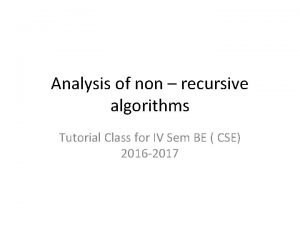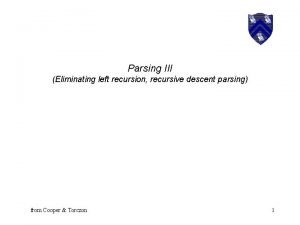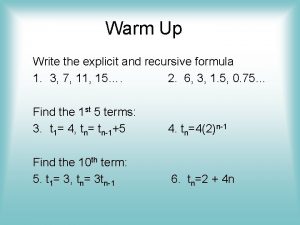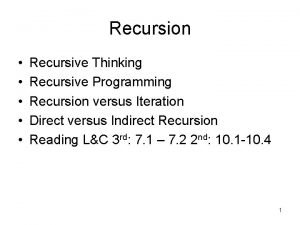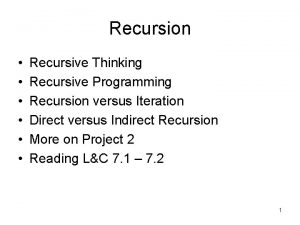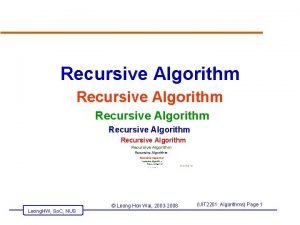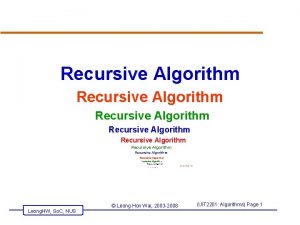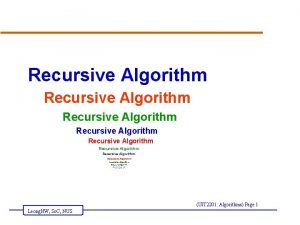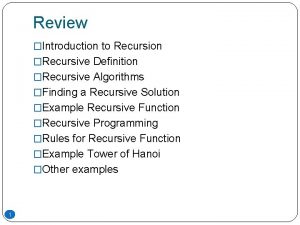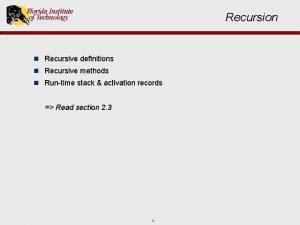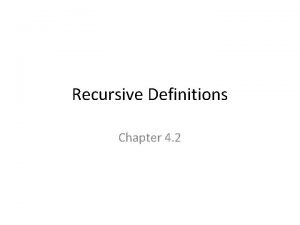Recursion Overview l Introduction to recursion and recursive








![Recursion: The Fiboacci Function l Fibonacci public static void main (String[] args) throws IOException Recursion: The Fiboacci Function l Fibonacci public static void main (String[] args) throws IOException](https://slidetodoc.com/presentation_image_h/a3b7d63e3360d716e1c83cedc0c325a4/image-9.jpg)

- Slides: 10

Recursion Overview l Introduction to recursion and recursive methods l Simple popular recursive algorithms l Writing recursive methods l Preview: Parameter passing 1

Recursion l l l We have mentioned earlier that a method can call itself directly or indirectly using an intervening method. A recursive method is a method that calls itself. A well-defined recursive method has » A base case; » A recursive step which must always get “closer” to the base case from one invocation to another. l The code of a recursive method must be structured to handle both the base case and the recursive case. l Each call to the method sets up a new execution environment, with new parameters and local variables. l As always, when the method completes, control returns to the method that invoked it (which may be an earlier invocation of itself). 2

Recursion: The Factorial Function l The factocial function is defined as: » n! = n*(n-1)*(n-2)*…*1 import java. io. IOException; import Text. IO; class Factorial { static Text. IO input. Stream = new Text. IO(System. in); public static int factorial(int num) { if (num == 0) return 1; else return num*factorial(num-1); } public static void main (String[] args) throws IOException { int n, answer; System. out. println("Enter an integer: "); n = input. Stream. read. Int(); answer = factorial(n); System. out. println("The factorial of” + n + " is ” + answer); } } 3

Recursion: Sample Execution Trace l Factorial: A Sample Trace factorial (6) = =(6*Factorial(5)) =(6*(5*Factorial(4))) =(6*(5*(4*Factorial(3)))) =(6*(5*(4*(3*Factorial(2))))) =(6*(5*(4*(3*(2*Factorial(1)))))) =(6*(5*(4*(3*(2*1))))) =(6*(5*(4*(3*2)))) =(6*(5*(4*6))) =(6*(5*24)) =(6*120) =720 4

Recursion: sum. Of. Squares l sum. Of. Squares: Specified as: sum. Squares(m, n)=m^2+(m+1)^2+(m+2)^3+…+n^2 import java. io. *; import Text. IO; class Sum. Of. Squares { static Text. IO input. Stream = new Text. IO(System. in); static int sum. Squares(int from, int to) { if (from < to) return from*from + sum. Squares(from+1, to); else return from*from; } 5

Recursion: sum. Of. Squares (cont. ) l sum. Of. Squares (continued) public static void main (String[] args) throws IOException { int from, to, answer; System. out. println("Enter the smaller integer: "); from = input. Stream. read. Int(); System. out. println("Enter the bigger integer: "); to = input. Stream. read. Int(); answer = sum. Squares(from, to); System. out. println("Sum of Squares from "+ from + " to " +to+" is "+ answer); } } 6

Recursion: sum. Of. Squares Execution Trace l sum. Squares: A Sample Trace sum. Squares (5, 10) = =(25+sum. Squares(6, 10)) =(25+(36+sum. Squares(7, 10))) =(25+(36+(49+sum. Squares(8, 10)))) =(25+(36+(49+(64+sum. Squares(9, 10))) )) =(25+(36+(49+(64+(81+(sum. Squares(10 , 10))))))) =(25+(36+(49+(64+(81+100))))) =(25+(36+(49+(64+181)))) =(25+(36+(49+245))) =(25+(36+294)) =(25+330) =355 7

Recursion: The Fibonacci Function l The famous Fibonacci function is defined as fib 0 = 1 fib 1 = 1 fib n = fib(n-1)+fib(n-2), n>=2. import java. io. *; import Text. IO; class Fibonacci { static Text. IO input. Stream = new Text. IO(System. in); static int fibonacci (int num) { if (num == 0 || num == 1) return 1; else return (fibonacci(num-1) + fibonacci(num-2)); } 8
![Recursion The Fiboacci Function l Fibonacci public static void main String args throws IOException Recursion: The Fiboacci Function l Fibonacci public static void main (String[] args) throws IOException](https://slidetodoc.com/presentation_image_h/a3b7d63e3360d716e1c83cedc0c325a4/image-9.jpg)
Recursion: The Fiboacci Function l Fibonacci public static void main (String[] args) throws IOException { int n, answer; System. out. println("Enter an integer: "); n = input. Stream. read. Int(); answer = fibonacci(n); System. out. println("The "+n+ "th Fibonacci number is: "+ answer); } } 9

Recursion: Simple Popular Recursive Algorithms (cont. ) l Exercises: Write complete recursive programs for the following algorithms 1 power(x, y) that implements x^y using repeated additions and without using multiplication. Assume x to be a floating point value and y to be a nonnegative integer. 2 gcd(m, n) that implements the Euclid’s algorithm of finding the greatest common divisor of m and n. Assume m and n to be positive integers. 3. is. Plaindrome() which given a string prints an informative error message saying whether or not the given string is a palindrome (reads the same when read from left to right or from right to left). 10
 Non recursive algorithms
Non recursive algorithms Eliminating left recursion
Eliminating left recursion To understand recursion you must understand recursion
To understand recursion you must understand recursion Multicullar
Multicullar Introduction to recursion
Introduction to recursion Papercut job ticketing
Papercut job ticketing Introduction product overview
Introduction product overview Introduction product overview
Introduction product overview Introduction product overview
Introduction product overview Quadratic recursive formula
Quadratic recursive formula Recursive halving and doubling algorithm
Recursive halving and doubling algorithm
